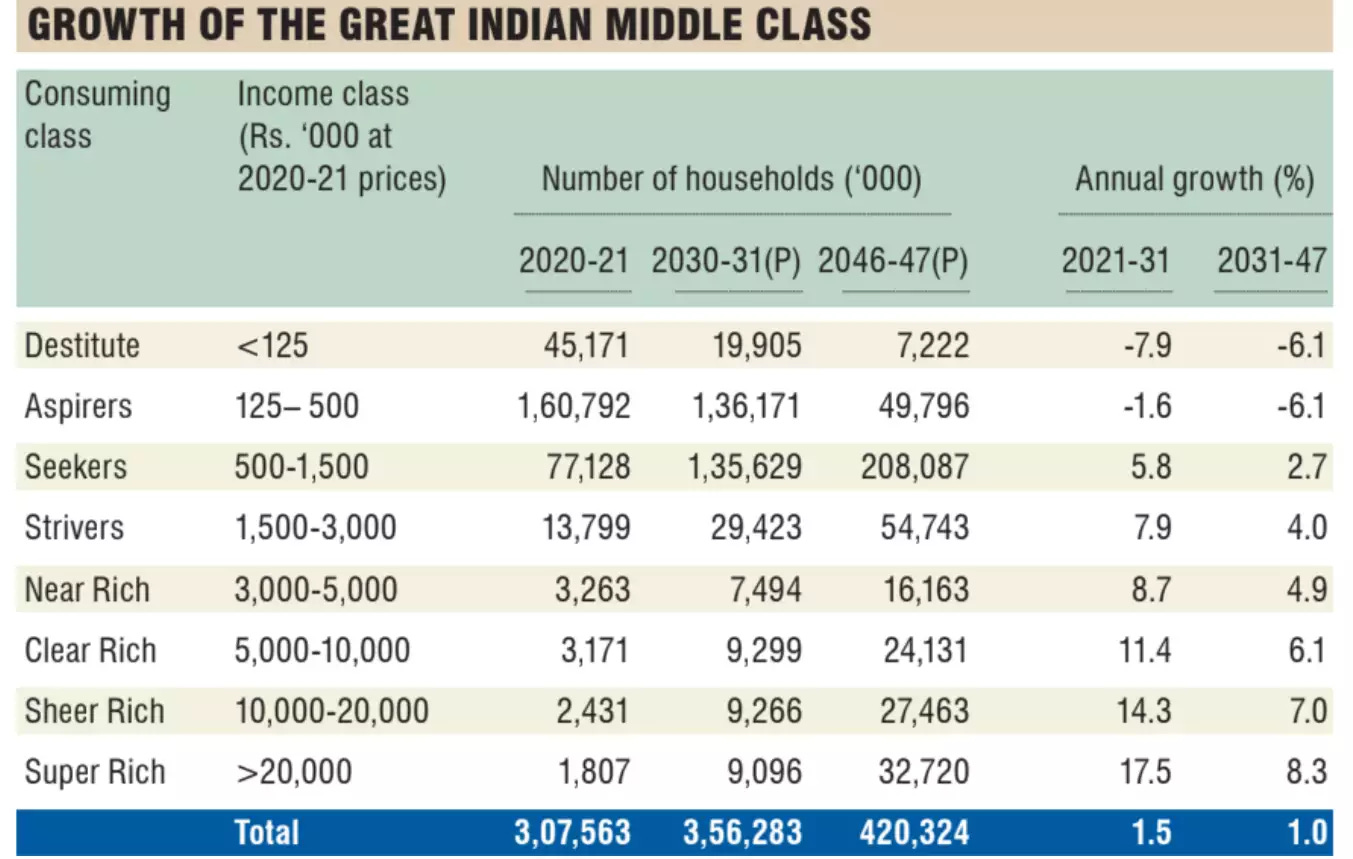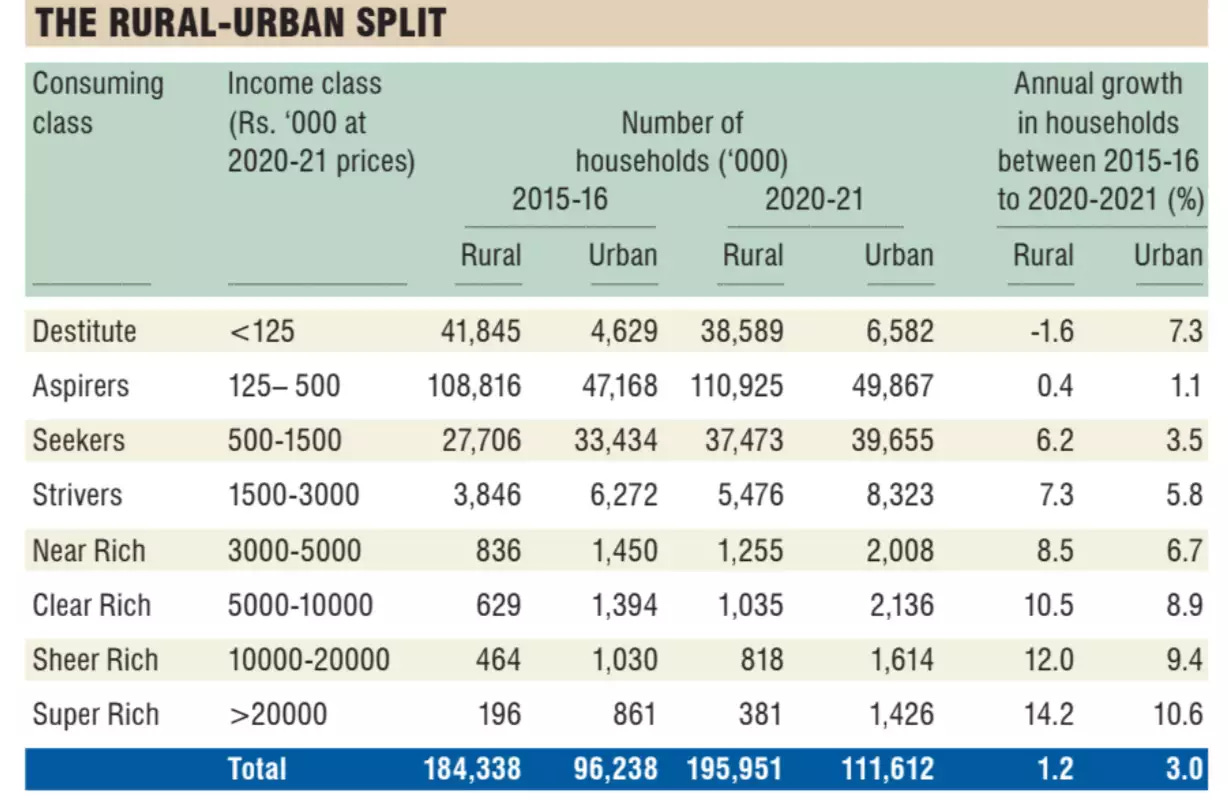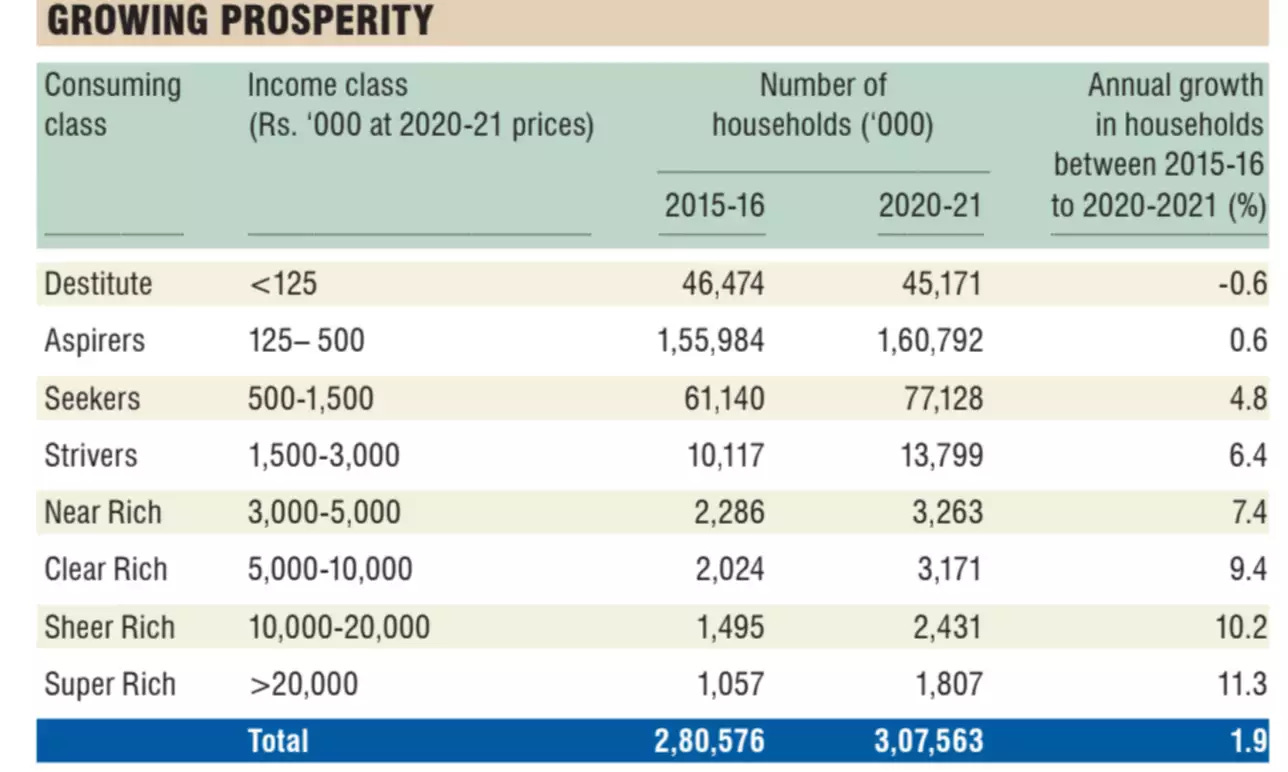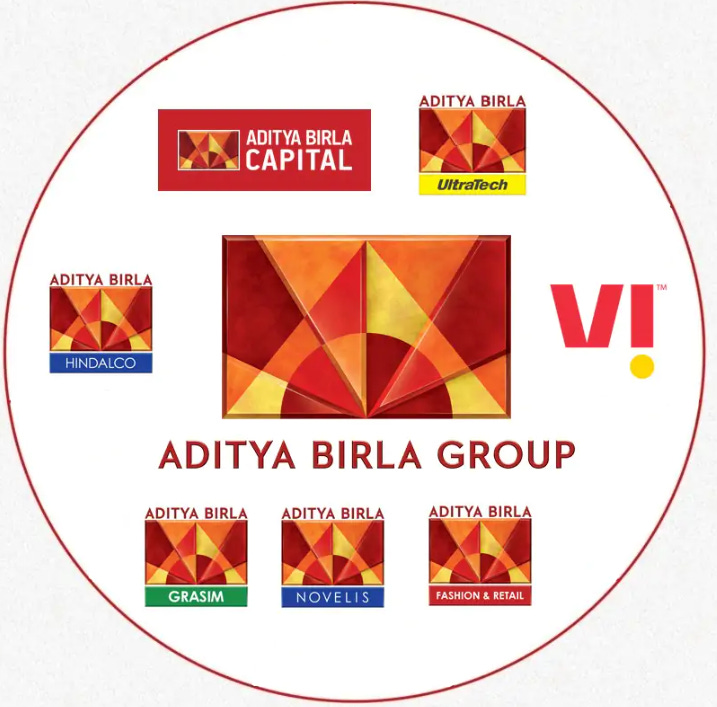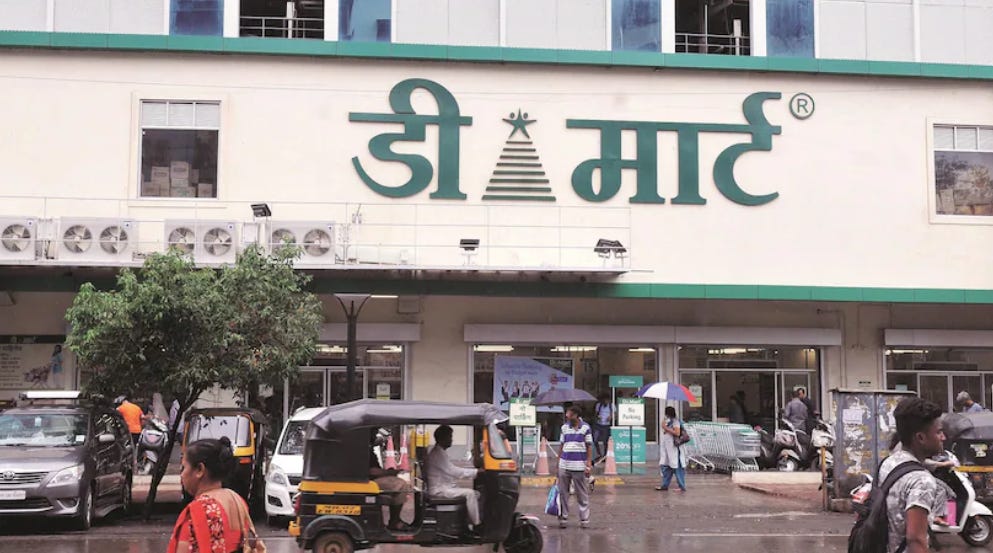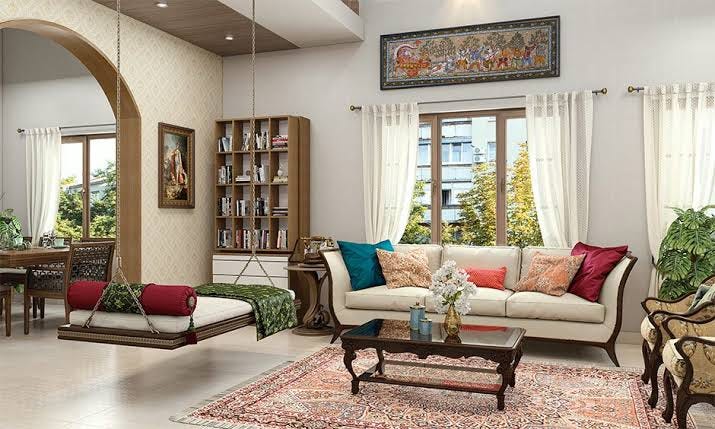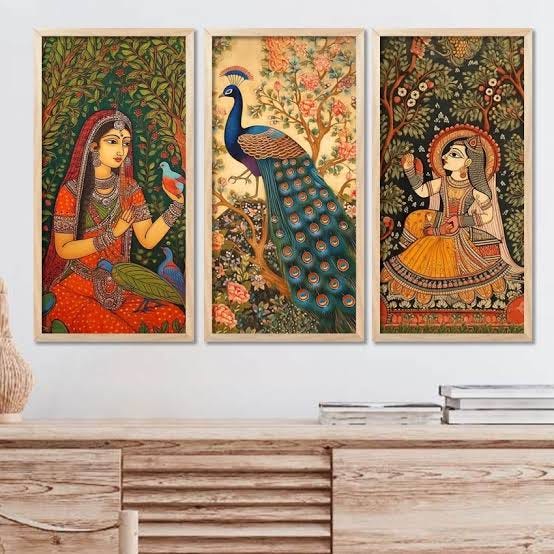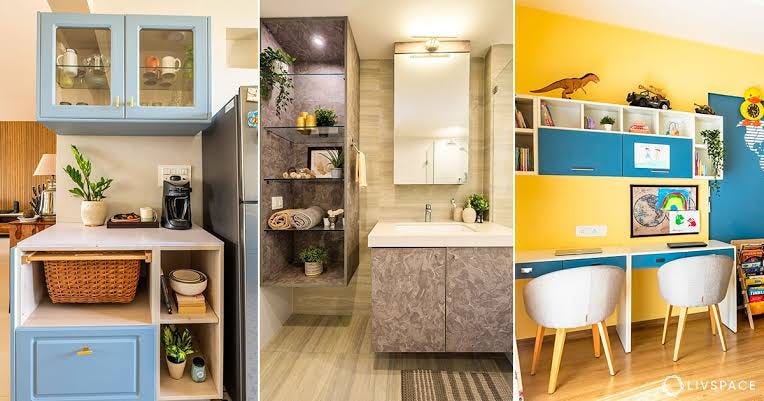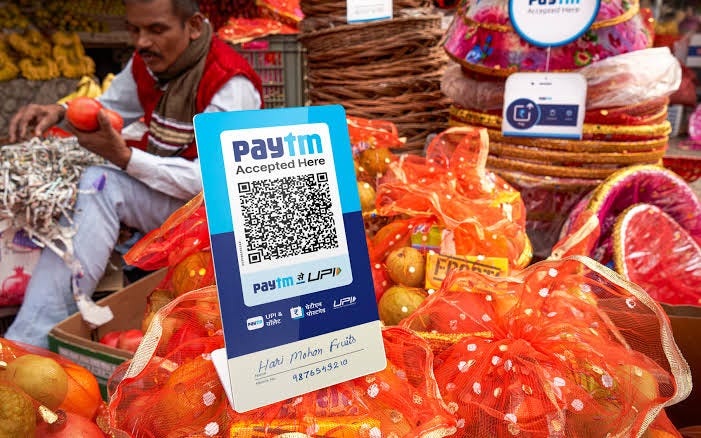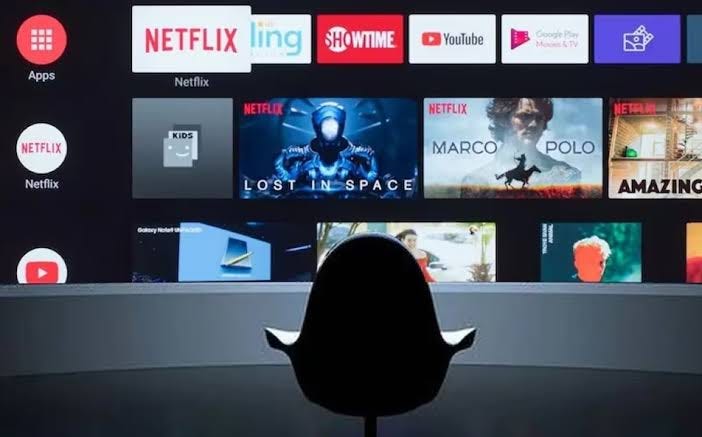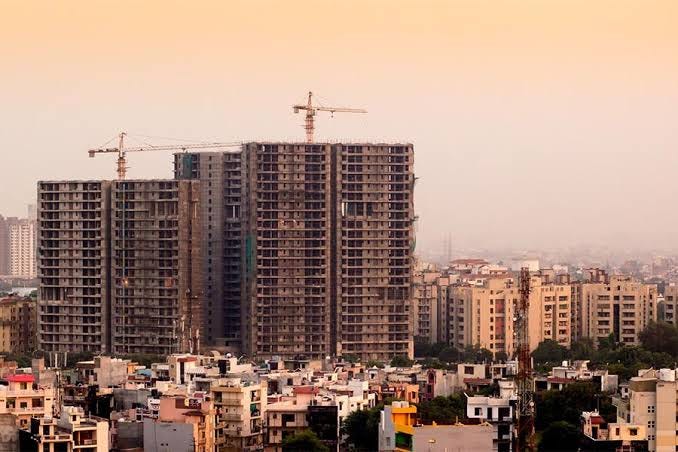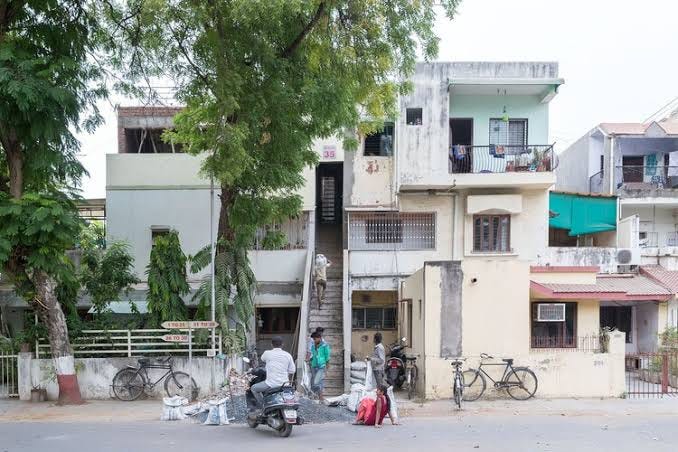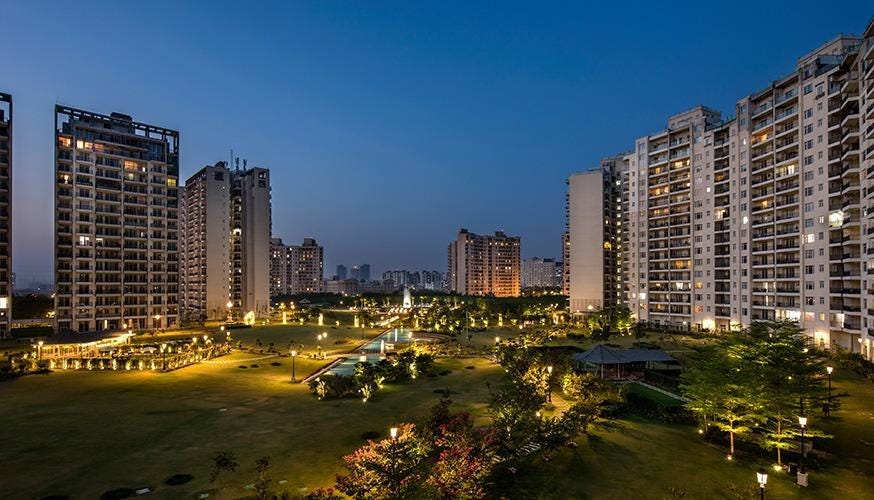India’s middle class is not just growing—it’s evolving. With rising incomes and bigger dreams, this transformation is deeply personal, reflecting changing aspirations and lifestyles. No longer satisfied with just sasta, sundar, tikau products, today’s consumers seek quality, experience, and self-expression. Whether it’s upgrading to organic atta, choosing premium skincare, or buying that dream smartphone, spending habits now reflect status and self-care rather than just affordability.
This shift is reshaping industries across the board. Retail is booming with global aur desi brands finding space in every middle-class ghar. The real estate market is seeing a surge in demand for luxury amenities wala housing. Meanwhile, technology has become a must-have—smartphones, AI gadgets, and home automation are now middle-class ke naye dost! As businesses race to keep up, one thing is clear—India’s middle class is no longer just a market segment; yeh toh asli game changer hai!
1. The Growth of India’s Middle Class
1. Rising Incomes and Spending Power
Expansion of the Middle Class
Growth Rate: Between 2015-16 and 2020-21, the 'Strivers' subgroup of the Indian middle class, with annual household incomes between ₹15 lakh and ₹30 lakh, grew at a rate of 6.4% per year. The 'Seekers' subgroup, earning between ₹5 lakh and ₹15 lakh annually, experienced a 4.8% annual growth during the same period.
Current Proportion: As of 2021, the middle class constitutes approximately 31% of India's population.
Future Projections: This demographic is anticipated to expand to 41% by 2031 and further to 60% by 2047.
Disposable Income and Consumption
Income Growth: The average real household disposable income in India is projected to reach ₹318,896 by 2025, up from ₹113,744 in 2005, reflecting a compound annual growth rate of 5.3%.
Consumption Patterns: India's household consumption has doubled over the past decade, reaching $2.1 trillion in 2023. This surge positions India to become the world's third-largest consumer market.
Premiumization Trend: Urbanization and increased exposure to global markets have fostered a demand for premium products and lifestyle-driven consumption among urban households.
2. Urbanization and Lifestyle Shifts
Urban Population Growth
Current Urbanization Level: As of 2023, approximately one-third of India's total population resides in urban areas, marking an increase of over 4% in the last decade.
Future Outlook: Projections indicate that by 2047, more than 50% of India's population will be living in urban areas, signifying a significant demographic shift.
Urban Market Recovery: A Turning Point?
Recent data suggests that India’s urban FMCG market may be on the verge of a turnaround, fueled by tax benefits from the recent budget that could boost short-term consumption. "We do see some short-term consumption impetus, which is expected to further consolidate urban's position this year. No major thrust areas are evident for rural in the same vein, so it is likely that urban may end up leading rural for most of the year," said K Ramakrishnan, Managing Director, South Asia, Worldpanel division at Kantar.
For most FMCG companies, urban markets account for 50% to 70% of their overall sales. Over the past year, inflationary pressures, low wage growth, and rising housing costs weighed on urban demand for daily groceries and staples. While many companies—including Hindustan Unilever, Godrej, and Marico—reported that urban growth lagged behind rural growth, Kantar's data suggests that unbranded products in urban areas grew at a faster rate (8.6%) compared to rural markets (1.6%). This indicates that inflation-led downtrading—where consumers shift to lower-priced or unbranded alternatives—is impacting the growth of branded FMCG products.
“We are probably seeing some signs of downtrading in categories like household insecticides,” said Sudhir Sitapati, Managing Director at Godrej Consumer Products, during an earnings call. “We have to watch the space carefully in terms of urban consumption, but it is certainly a cause for concern.”
Impact on Consumer Behavior
Modern Retail and E-commerce: Urbanization has led to a shift from traditional retail formats to modern retail and e-commerce platforms, with urban consumers seeking convenience and variety.
Lifestyle Changes: Urban living has influenced food demand, with significant differences observed between urban and rural consumption patterns.
Demand for Premium Products: Urban consumers are increasingly seeking products and experiences that enhance quality of life, driving demand for premium offerings.
2. FMCG: From Essentials to Premiumization
From Everyday Essentials to Premium Treats – The FMCG Chessboard is Changing
Picture this: You walk into a supermarket for a simple bar of soap, and suddenly, you're faced with a crisis of choice. On one shelf, a legacy FMCG giant offers its ‘trusted for generations’ product, while right next to it, a new D2C brand claims it’s made with organic unicorn tears and Himalayan moonlight. Meanwhile, a regional brand winks at you with a ‘better value for money’ sticker.
Welcome to the new battleground of India's FMCG industry, where old-school titans, nimble D2C challengers, and regional underdogs are fighting for their share of your shopping cart.
The Battle Lines Are Drawn
Saugata Gupta, MD & CEO of Marico Ltd, puts it best—competition is coming from all sides.
👉 On one end, D2C brands are swooping in with premium, Instagrammable products—think Ayurvedic protein bars, charcoal face masks, and fancy peanut butter. These brands have nailed online marketing, making traditional FMCG giants sweat.
👉 On the other end, regional players—who faced supply chain hiccups during the pandemic—are bouncing back strong with affordable, no-frills essentials. Your local brand of hair oil or detergent? It’s making a comeback, and it’s coming for the big boys.
And guess what? Smaller FMCG brands are outpacing the big ones in volume growth. According to NielsenIQ, in the December quarter, smaller firms posted a 9.7% year-on-year volume growth, more than double the 4.4% growth seen by industry heavyweights.
Urban Consumers Are Spending—But They’re Choosy
Urban shoppers are slowly loosening their purse strings, with demand for daily essentials rising 5.3% YoY, up from 4.3% last quarter (Kantar data). But here’s the catch—inflation is squeezing wallets, making consumers think twice before picking up their favorite FMCG products.
👉 Premium body wash or budget-friendly soap bar? Soap bar wins.
👉 Expensive organic juice or a good ol’ glass of nimbu paani? Nimbu paani wins.
👉 Fancy imported shampoo or trusted regional brand? Regional brand wins.
Meanwhile, rural growth has stagnated at 3.9%, showing that affordability is king outside big cities.
How Are the Big FMCG Players Fighting Back?
Faced with this double attack from both premium D2C players and budget-friendly regional brands, FMCG giants are leveling up their game:
✔️ Premiumization: Launching higher-end products to attract aspirational buyers. Think "Masala Oats for Fitness Enthusiasts" instead of just plain oats.
✔️ Acquisitions: Buying out successful smaller brands before they become a bigger threat. (Remember how ITC got into the D2C skincare game?)
✔️ Wider Distribution: Expanding reach into deeper rural pockets and smaller cities to maintain dominance.
But is that enough? With digital-first brands creating a cult-like following and regional players pricing aggressively, the battle for India's shopping carts is just getting started.
So, the next time you find yourself choosing between a premium D2C face cream, a nostalgic legacy brand, or a budget-friendly regional alternative, remember—you’re not just shopping, you’re voting in the FMCG war. 🛒🔥
India’s Consumer Market is Leveling Up—And It’s Getting Competitive
If the FMCG industry were a Bollywood movie, we’d be at the part where the young, ambitious challenger storms in to shake things up, while the seasoned veterans scramble to adapt. Enter India’s new-age digital-first brands—the cool, Instagram-friendly startups selling everything from charcoal-infused face masks to protein-rich peanut butter. These D2C brands exploded onto the scene, backed by venture capital, influencer marketing, and algorithms that know your shopping habits better than your own mom.
But now, reality is setting in.
The Shift from “Hype” to “Survive”
The D2C boom wasn’t just about cool packaging and viral ads. Many of these brands spent heavily on digital marketing and customer acquisition—sometimes more than what they made in revenue (ouch!). But as funding tightens and profitability takes center stage, these startups are shifting gears:
✅ From "Burn Money" to "Earn Money" – Gone are the days of endless discounts. Brands are now focusing on repeat customers and brand loyalty.
✅ From Just Online to Everywhere – Many digital-first brands are moving into offline retail, because let’s face it, not everyone is browsing for almond butter on Instagram.
✅ From Niche to Mainstream – What started as luxury or wellness-focused brands are now expanding into mass-market categories to stay relevant.
Meanwhile, traditional FMCG giants like Marico, ITC, and HUL are taking notes. They’re not just watching from the sidelines—they’re actively buying out or collaborating with D2C players to keep their dominance intact.
The Battle of Distribution: Online vs. Offline
While e-commerce and organized trade are on the rise, small retailers and general trade are feeling the heat. The old-school “kirana store” is under pressure, squeezed between rising consumer expectations and tech-driven competitors.
FMCG giants like Marico are fighting back by working closely with distributors to:
✔️ Streamline pricing strategies – No more confusing price wars between online and offline channels.
✔️ Resolve channel conflicts – Ensuring that online discounts don’t kill traditional retail sales.
✔️ Optimize inventory management – Using data to keep supply smooth across platforms.
The result? A market where convenience meets affordability, and brands need to cater to both online shoppers and the traditional, “bargain-driven” consumer.
India’s Middle Class is Trading Up: It’s Not Just About Cheap Anymore
For years, FMCG was all about affordability—think economy-size soaps and budget-friendly biscuits. But the Indian middle class is evolving, and so are their shopping habits. Premiumization is the name of the game, with consumers willing to pay more for quality, health benefits, and brand trust.
Organic foods? Growing fast.
Luxury skincare? No longer just for Bollywood stars.
Healthy, protein-packed snacks? Now a daily essential.
This shift means brands can’t just sell "cheap and best" anymore. They need to offer value, convenience, and a premium experience—or risk being forgotten.
Key Trends in FMCG
FMCG Volume Growth (%, YoY)
✅ Premiumization: Consumers prefer branded, high-quality products over unbranded or generic ones.
✅ Health & Wellness: Growing demand for organic, plant-based, and sugar-free products.
✅ E-commerce Boom: Online grocery shopping is reshaping distribution channels.
3. Retail: Organized Players Gaining Ground
Remember when shopping meant haggling with your local kirana store uncle, who gave you a discount only if you bought extra biscuits? Well, those days are slowly fading. Welcome to the era of organized retail, where convenience, variety, and tech-driven experiences are reshaping how Indians shop.
With India’s organized retail sector set to hit $230 billion by 2030 (growing at a 10% CAGR), one thing is clear—Indians are spending more and expecting more. From premium grocery stores to online shopping sprees at midnight, consumer preferences are evolving faster than ever.
Meet the Giants: Who’s Leading the Retail Revolution?
Not all superheroes wear capes—some own shopping malls, hypermarkets, and e-commerce platforms. Here are the key players shaping India's retail future:
Reliance Industries Limited
Think of Reliance as the "one-stop shop for everything"—groceries, fashion, electronics, and even your neighbor’s favorite sweets. Whether it's Reliance Fresh, Smart Bazaar, or JioMart, they’re dominating both online and offline spaces.
Aditya Birla Group
From Pantaloons to More Supermarkets, Aditya Birla has both your wardrobe and grocery list covered. Their ability to blend affordability with aspirational products keeps them ahead in the game.
DMart (Avenue Supermarts Limited)
DMart is where you go to buy five things but end up with twenty—because their discounts are that good. Known for its value-for-money strategy, DMart’s efficiency-driven model ensures customers save more every time they shop.
Tata Group
With brands like Croma (electronics) and Trent (fashion), Tata is expanding its empire into every corner of retail. Whether you need a refrigerator or a new suit, there’s a Tata-owned store ready for you.
V-Mart Retail Ltd.
Tier 2 and Tier 3 cities, rejoice! V-Mart is bringing branded fashion to your doorstep without burning a hole in your pocket. Affordable yet stylish, it's a favorite among India’s growing middle class.
The Rise of Quick Commerce: Why Wait When You Can Have It Now?
If patience is a virtue, quick commerce is happily ignoring it.
Platforms like Blinkit, Zepto, and Swiggy Instamart have redefined shopping with ultra-fast deliveries—sometimes in less time than it takes to find your car keys.
✅ Growth rate? A mind-blowing 75-100% YoY (traditional retail grows in the low teens—so yes, quick commerce is winning).
✅ Why the craze? Because who has time to wait for groceries when there’s a Netflix binge session pending?
✅ Market size? India’s top 40-50 cities have a $250 billion grocery market, and quick commerce is grabbing a huge chunk.
But there’s a downside…
Quick Commerce vs. Traditional Retail: Who’s Winning?
Kirana stores (which still control 75% of India’s retail trade) are feeling the heat. With digital payments and click-and-buy convenience taking over, consumer loyalty is shifting.
Imagine this: Why walk to your local store when Zepto delivers in 10 minutes? Exactly.
Marico’s Strategy: The ‘Setu’ to Retail Dominance
Some brands are adapting instead of complaining. Marico, known for Parachute coconut oil and Saffola, is expanding its direct distribution under ‘Project Setu’:
Investment? ₹70-100 crore over 3 years.
Retail reach? From 1 million outlets to 1.5 million outlets by FY27.
Why? Because the more stores they reach directly, the less dependent they are on middlemen—keeping costs low and supply chains smooth.
The Fashion Boom: Middle Class, Middle Fashion? Not Anymore!
For years, middle-class shopping meant buying three shirts for ₹999 during festive sales. But not anymore!
India’s apparel market is on a stylish growth trajectory:
Market size in 2023? $106.87 billion.
Expected by 2030? $139.54 billion (CAGR of 3.88%).
What’s driving growth? Rising incomes, global trends, and a shift towards branded clothing.
It’s no longer just about owning clothes—it’s about owning brands that signal lifestyle upgrades.
The Omnichannel Shopping Experience: The Best of Both Worlds
Shoppers today don’t just walk into a store and buy things—they check reviews, compare prices online, visit the store, touch the fabric, then order it online for home delivery.
✅ 57% of shoppers still prefer in-store shopping (because touching beats scrolling).
✅ 38% like the buy-online, pick-up-in-store model (because waiting for deliveries is a pain).
✅ Hybrid shopping is the future—retailers who blend digital and physical experiences will thrive.
The Verdict: Retail’s Future is Bright, But Only for the Smart Players
India’s retail sector is in beast mode, but only companies that adapt to changing trends will survive. The battle between organized retail, quick commerce, and traditional kirana stores is heating up, and the winners will be those who:
✔️ Invest in faster delivery & omnichannel experiences.
✔️ Expand their physical and digital reach.
✔️ Stay affordable while offering aspirational products.
With India’s middle class growing to 165 million+ people earning over $10,000 per year by 2030, the real question isn’t whether retail will grow—it’s who will dominate it.
So, whether you’re adding things to your Blinkit cart or picking up groceries at DMart, just know—you’re part of India’s great retail transformation. 🎉
4. Home Décor & Home Improvement: A Sector of Aspirational Growth
If home decor were a Bollywood blockbuster, India’s middle class would be the star, the director, and the audience—all at once. Gone are the days when a fresh coat of paint and a couple of cushions were enough to refresh a home. Today, it's all about modular furniture, smart home gadgets, and premium finishes that scream, "I have arrived!" (without actually breaking the bank).
Home: No Longer Just a Shelter, But a Statement
For the Indian middle class, a home isn’t just four walls and a roof—it’s a symbol of success, taste, and convenience. With rising disposable incomes and easy financing, homeowners are prioritizing:
✅ Smart designs that maximize every inch of space.
✅ Modular and premium interiors (because who has time for old-school carpenters?).
✅ Tech-driven living (yes, even your tube light should listen to voice commands now).
The goal? Not over-the-top luxury, but practical elegance that impresses both guests and the in-laws.
Painting the Town (and Walls) with Premium Finishes
The Indian paint industry is booming, set to double from ₹1,110 billion in FY24 to ₹2,640 billion by FY33. But today, it’s not just about color; it’s about stain-resistant, eco-friendly, and odor-free finishes.
What’s trending? Earthy tones like beige, cream, and ash gray (because minimalism is the new luxury).Who’s leading the market? Asian Paints, with its vast network of 160,000+ retail points, ensuring every home gets a premium touch. Affordable luxury? Kansai Nerolac is bringing premium paints within reach of middle-class homeowners who want both quality and value.
The message is clear: Ditch the boring walls and upgrade to designer textures!
Modular Furniture: Where Style Meets Smart Space
With urban homes shrinking faster than our patience in traffic, modular furniture has become the go-to solution for maximizing space without compromising on aesthetics.
Price range? From ₹1,250 per sq. ft. for budget-friendly modular setups to over ₹100,000 for high-end designs. Most in-demand? Modular kitchens. Because who doesn’t want a sleek, space-saving setup that also hides the mess? Why the shift? Traditional carpentry is time-consuming, inconsistent, and, let’s be honest, not as cool.
Companies like IKEA and Livspace are revolutionizing the market, offering stylish yet functional furniture that fits the new-age home.
Smart Homes: The Future is Now
What was once considered a luxury for the elite is now becoming mainstream. Smart home technology is transforming how we interact with our living spaces.
Popular choices? Smart lighting, AI-powered security cameras, and voice-controlled appliances. Why now? Prices have dropped, making high-tech convenience affordable beyond metro cities. The impact? Middle-class homes are not just stylish but also intelligent, energy-efficient, and future-ready.
Next time your friend adjusts the AC with their voice while serving snacks from a hidden pull-out drawer, don’t be surprised. This is the new middle-class reality!
The Flip Side: Plastic Pipes & Infrastructure Face Headwinds
While home décor is soaring, the plastic pipes and infrastructure segment is facing one of its worst slowdowns ever. Industry expert Mr. Vijay Mahnot explains why:
📉 Demand is Extremely Weak:
With the Jal Jeevan Mission (JJM) nearing completion, infrastructure-related pipe demand has plunged.
The agriculture sector hasn’t picked up, as unseasonal rains delayed demand.
📈 Market Leaders vs. Struggling Players:
Top branded players only got 30% of JJM orders, while unorganized players dominated with 95% of HDPE pipes.
The price gap between local players and market leaders has shrunk from ₹15/kg to just ₹2–3/kg, intensifying competition.
🌐 What’s Next?
Capacity Utilization is at ~40% (ouch!).
FY26 looks promising, but FY25 remains challenging.
Logistics cost control is crucial, and companies with multiple manufacturing locations will have an edge.
Home Décor is Winning the Upgrade Game
India’s middle class is redefining home décor with smarter, more stylish, and tech-savvy choices. Whether it’s:
A modular kitchen that makes cooking feel less like a chore,
A premium paint finish that keeps walls looking fresh, or
A smart home that listens better than your spouse—
...this new wave of aspirational living is here to stay. The future of Indian homes? Compact, chic, and connected!
The Big Picture: India’s Middle Class Wants a Lifestyle Upgrade
Whether it’s premium paints, modular kitchens, or AI-powered homes, the middle class is making its dreams a reality—one smart purchase at a time.
So, if you walk into a friend’s house and see them dimming the lights with their voice while their sleek modular kitchen hides an entire pantry behind a sliding panel—don’t be surprised. This is the new middle-class reality.
And if your home still has creaky old furniture and tube lights that flicker like a horror movie? Maybe it’s time for an upgrade too.
5. The Rise of Technology Adoption
India's burgeoning middle class is at the forefront of a digital revolution, significantly altering content consumption, payment methods, and business interactions.
Key Trends in Technology
Smartphone Penetration
Rapid Growth: As of early 2024, India had approximately 659 million smartphone users, accounting for 46.5% of its population.
Market Expansion: In 2024, India's smartphone market experienced a 5% year-over-year growth, with shipments reaching 155.9 million units. This growth was driven by the pandemic refresh cycle and 5G upgrades.
Digital Payments Boom
UPI Dominance: The Unified Payments Interface (UPI) has revolutionized digital payments in India. In January 2025, UPI transactions reached a record 16.99 billion, with a total value exceeding ₹23.48 trillion.
Yearly Surge: Between April and August 2024, UPI transaction volumes reached 7,062 crore, reflecting a compound annual growth rate (CAGR) of 129% since FY 2017-18.
Rise of EdTech & E-learning
Post-Pandemic Adoption: The COVID-19 pandemic accelerated the adoption of online education platforms. Middle-class households increasingly turned to e-learning solutions, leading to a surge in platforms offering diverse courses and virtual classrooms.
Government Initiatives: Initiatives like the Digital India campaign have further bolstered the e-learning ecosystem, making education more accessible to remote and underserved regions.
OTT & Digital Content Consumption
Streaming Surge: Over-the-top (OTT) platforms such as Netflix, Amazon Prime Video, and Disney+ Hotstar have seen substantial growth. The demand for diverse and regional content has led to increased subscriptions among middle-class consumers.
Content Localization: To cater to varied linguistic preferences, OTT platforms are investing in localized content, making entertainment more relatable and engaging for a broader audience.
E-commerce and Online Services
Market Expansion: The e-commerce sector has witnessed exponential growth, with middle-class consumers increasingly shopping online for convenience and variety. This trend extends to sectors like food delivery, fintech, and ride-sharing services.
Fintech Innovations: Digital wallets and fintech solutions have become integral to daily transactions, offering seamless payment experiences and financial management tools.
Technological Advancements in Manufacturing
Local Production: To reduce dependency on imports and boost local manufacturing, India has removed import duties on certain smartphone components. This move benefits companies like Apple and Xiaomi, encouraging them to expand production within the country.
Global Partnerships: Collaborations between Indian firms and global tech companies are fostering innovation and technological advancements, further propelling the digital economy.
6. Real Estate: Housing Demand on the Rise
India's real estate market is experiencing significant growth, propelled by rising incomes, rapid urbanization, and shifting consumer aspirations. These factors have led to a notable increase in homeownership and real estate investments across various segments.
Key Trends in Real Estate
Affordable & Mid-Segment Housing
Market Valuation: India's affordable housing market is projected to reach ₹67 trillion, with a demand for 31.2 million units by 2030.
Demand Surge: The need for affordable housing is expected to grow at a compound annual growth rate (CAGR) of 19.80% through 2030, driven by increasing urbanization and the pressing need to address housing shortages for economically weaker sections (EWS), low-income groups (LIG), and middle-income groups (MIG).
Premium Housing Demand
Luxury Market Growth: In the first quarter of 2024, the share of luxury home sales almost equaled that of affordable homes, reaching 21%.
Price Appreciation: National home prices, which grew 4.3% last year, are expected to increase by 7.75% this year and another 6.0%-6.25% over the next two years, driven by demand from high-net-worth individuals and post-pandemic high-income earners.
Home Loans & Interest Rates
Increased Lending: Financial institutions have reported a surge in home loan disbursements. For instance, PNB Housing Finance posted a 43% increase in third-quarter profit, reaching ₹4.83 billion, driven by strong home loan demand.
Government Initiatives: Policies such as the Pradhan Mantri Awas Yojana (PMAY) have supported affordable housing projects, providing subsidies and tax benefits to first-time homebuyers, thereby boosting homeownership.
Tier 2 & 3 Cities Expansion
Market Growth: Cities like Indore, Jaipur, and Coimbatore are witnessing increased real estate investment due to better infrastructure and job opportunities.
Urbanization Impact: With over 35% of India's population living in urban areas—a figure expected to surpass 40% by 2030—the demand for affordable housing is set to soar, particularly in these emerging urban centers.
The Road Ahead
As India’s middle class continues to grow, industries catering to aspirational consumers are set to evolve rapidly. The increasing preference for premium products, branded retail experiences, and modern home solutions is likely to drive significant changes across multiple sectors.
Companies operating in these spaces are adapting by innovating product offerings, expanding digital presence, and focusing on quality to attract middle-class consumers. The coming years will likely see further shifts as urbanization, technology, and disposable incomes continue to reshape India's consumption patterns.
Thanks for reading EquityEdge Research! Subscribe for FREE!!
Thank you for reading till the end! We hope you enjoyed this report.
Researched By- Naresh, Mayank and Vaibhav
If you like the hard work we put in, you can invest in us:




